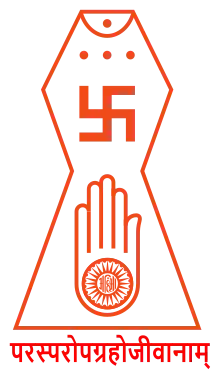Nālaṭiyār
The Nālaṭiyār (Tamil: நாலடியார்) is a Tamil poetic work of didactic nature belonging to the Eighteen Lesser Texts (Patiṉeṇkīḻkaṇakku) anthology of Tamil literature. This belongs to the post Sangam period corresponding to between 100 and 500 CE. Nālaṭiyār contains 400 poems, each containing four lines. Every poem deals with morals and ethics, extolling righteous behaviour.
| Author | Various poets |
|---|---|
| Working title | Naladiyar |
| Country | India |
| Language | Old Tamil |
| Series | Patiṉeṇkīḻkaṇakku |
| Subject | Secular ethics |
| Genre | Poetry |
| Published | Palm-leaf manuscript of the Tamil Sangam era (dated variously between 300 BCE and 7th century CE) |
| Part of a series on |
| Jainism |
|---|
 |
Etymology
The term Naladiyar is derived from the Tamil terms Naalu, a colloquial form of Naangu meaning “four”, adi meaning metrical feet or poetic metre, and aar referring to a honorific suffix. Thus Naladiyar refers to the work that contains four-lined verse. The work is also termed Naaladi Naanooru, sometimes spelled Naladi Nannurru, meaning "four hundred quatrains," since it has 400 verses in total.
Didactic nature
Nālaṭiyār was composed by Jain monks.[1] It is an anthology in the venba metre and is pessimistic in its outlook.[2] It is divided into three sections, the first section focusing on the importance of virtuous life, second section on the governance and management of wealth, and the third smaller section on the pleasures.
Nālaṭiyār is unique in the employment of similes, which help to teach the moral codes using simple examples from daily life. For example, one of the poems states that just like a calf placed in front of a vast herd of cows seeks out its mother unerringly and attaches itself, the deeds of the past home in on the doer and exact their price unfailingly.
Commentaries and translations
Naladiyar remains the highly praised ancient didactic text in Tamil next only to the Tirukkural. Several commentaries have appeared on the text, which includes three ancient commentaries. The three ancient commentaries were those by Padumanar, Dharumar (who has also written commentary on the Tirukkural), and an anonymous poet.[3]
The Nalidiyar was translated into English by G. U. Pope, F. J. Leeper, and Gnanou Diagou.[4]
Naladiyar was translated into Russian by N. Gordiychuk in 2016.[5]
Naladiyar was translated into Urdu by H. K. Ghazi, an Indian civil servant.[6]
Reception
The Naladiyar is next only to the Tirukkural in fame among the Tamil literary works. Along with the Tirukkural, it is one of the first books published in Tamil, when it came to print from palm leaf manuscripts for the first time in 1812.[7] There is an old Tamil proverb praising the Nālaṭiyār that says "Nālaṭiyār and the Tirukkural are very good in expressing human thoughts just as the twigs of the banyan and the neem trees are good in maintaining the teeth."
- ஆலும் வேலும் பல்லுக்குறுதி; நாலும் இரண்டும் சொல்லுக்குறுதி.
- (Aalum vaelum pallukkuruthi; naalum irandum sollukkuruthi)
- Literal translation: "Banyan and neem maintain oral health; Four and Two maintain moral health."
- (Here "Four" and "Two" refer to the quatrains and couplets of Nālaṭiyār and Tirukkuṛaḷ, respectively.)
Naladiyar is often referred to as Vellalar Vēdham (the sacred scripture of the Vellalar)[8]
See also
Notes
- Sheldon Pollock 2003, p. 293.
- Chatterjee, 2021, p. 77.
- Aravindan, M. V. (2018). உரையாசிரியர்கள் [Uraiaasiriyargal] (in Tamil) (8 ed.). Chennai: Manivasagar Padhippagam. p. 332.
- Gnanou Diagou (1877-1959). BnF Data. n.d. – via data.bnf.fr.
- "Translations" (PDF). tamil.ivka.rggu.ru. Russian State University for the Humanities. n.d. Retrieved 24 June 2021.
- "naladiyar". Retrieved 5 September 2021.
- Kovaimani and Nagarajan, 2013, p. 184.
- M. S. Ramaswami Ayyangar, B. Seshagiri Rao. Studies in South Indian Jainism: South Indian Jainism. Sri Satguru Publications. p. 57.
References
- Sheldon Pollock, ed. (2003), Literary Cultures in History: Reconstructions from South Asia, University of California Press, ISBN 0-520-22821-9
- M. G. Kovaimani and P. V. Nagarajan (2013). Tirukkural Aaivumaalai [Tirukkural Research Papers] (in Tamil) (1 ed.). Tanjavur: Tamil University.
- Roma Chatterjee, ed. (2021). India: Society, Religion and Literature in Ancient and Medieval Periods (1st ed.). New Delhi: Government of India, Ministry of Information and Broadcasting. ISBN 978-93-5409-122-3.
- Mudaliyar, Singaravelu A., Apithana Cintamani, An encyclopaedia of Tamil Literature, (1931) - Reprinted by Asian Educational Services, New Delhi (1983)
